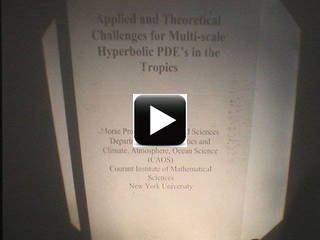One of the unexplained striking features of tropical convection is the observed statistical self-similarity, in clusters, superclusters, and intraseasonal oscillations through complex multi-scale processes ranging from the mesoscales to the equatorial synoptic scales to the intraseasonal/planetary scales. On the other hand, the accurate parameterization of moist convection presents a major challenge for accurate prediction of weather and climate through numerical models. After a brief survey of the observational record, this lecture summarizes recent work giving insight into these complex issues through the paradigm of modern applied mathematics done by the lecturer with various collaborators. This part begins with new multi-spatial scale, multi-time scale, simplified asymptotic models derived systematically from the equatorial primitive equations on the range of scales from mesoscale to equatorial synoptic to planetary/intraseasonal (Majda 2006.) All these simplified models show systematically that the main nonlinear interactions across scales are quasi-linear where eddy flux divergences of momentum and temperature from nonlinear advection from the smaller scale spatio-temporal flows as well as mean source effects accumulate in time and drive the waves on the successively larger spatio-temporal scales. Furthermore, these processes which transfer energy to the next larger, longer, spatio-temporal scales are self-similar in a suitable sense. The lecture continues with a brief summary of the multi-scale MJO models (Biello-Majda) and recent multi-cloud models (Khouider-Majda) for superclusters and their fidelity with key features of the observational record.
Superparameterization is a promising recent alternative strategy for including the effects of moist convection through explicit turbulent fluxes calculated from a cloud resolving model. Basic scales for cloud resolving modeling are the microscales of order 10km in space on time scales of order fifteen minutes where vertical and horizontal motions are comparable and moist processes are strongly nonlinear. Systematic multi-scale asymptotic analysis (Majda 2006) is utilized to develop simplified microscale mesoscale dynamic (MMD) models for interaction between the microscales and spatio-temporal mesoscales on the order of 100km and 2.5 hours. The new MMD models lead to a systematic framework for superparameterization for numerical weather prediction generalizing the traditional column modeling framework.
Finally this lecture ends with a new use of the multi-scale cloud models in the intraseasonal regime to produce realistic looking MJO analogue waves with intermittently propagating smaller scale eastward convection embedded in a planetary scale envelope moving at 5-7 ms-1 for flows above the equator. In the model, there are accurate predictions of the phase speed from linear theory and transitions from weak regular MJO analogues to more realistic strong multi-scale MJO analogue waves as climatological parameters vary. With all of this structure in a simplified context, these models should be useful for MJO predictability issues in a fashion akin to the Lorenz 96 model for predictability issues in the midlatitude atmosphere. This last work is joint with the lecturer, his Ph.D. student Sam Stechmann, and Boualem Khouider. Most of the papers in this research program can be found at Majda's faculty website: http://www.math.nyu.edu/faculty/majda/.
 Other video options
Other video options